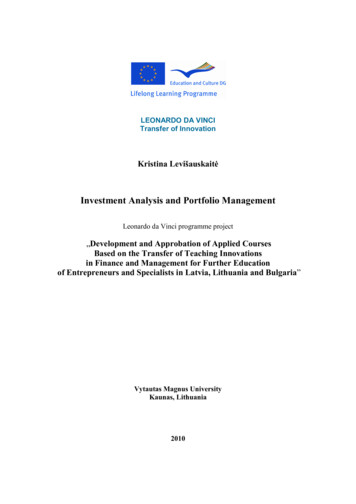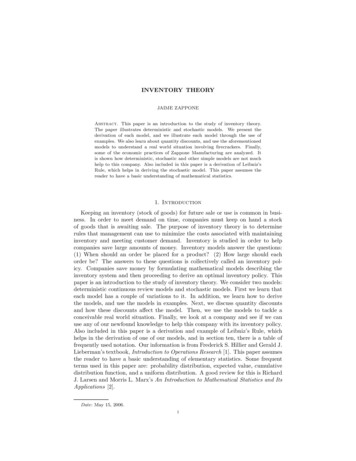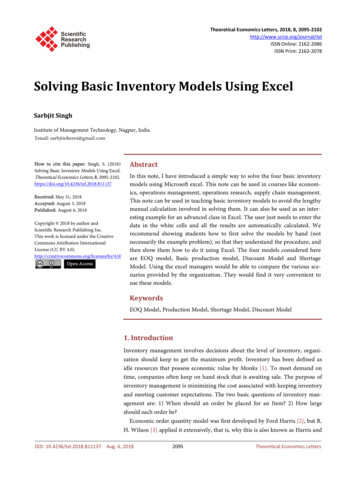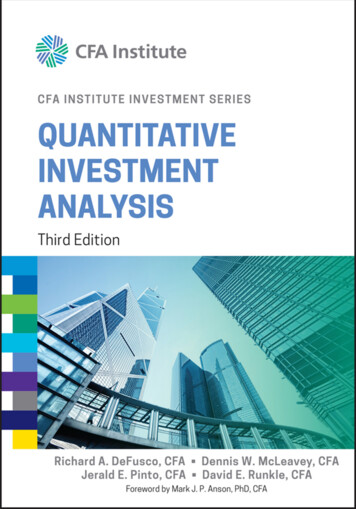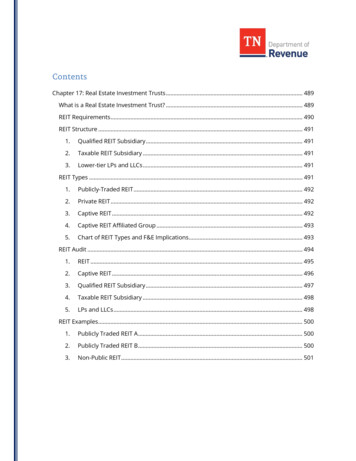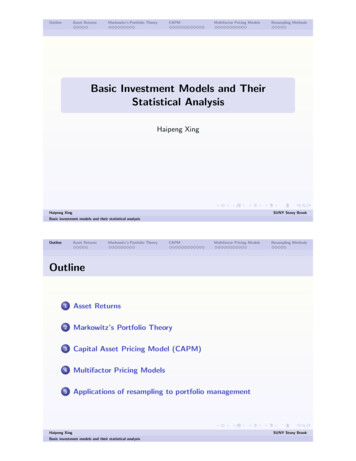
Transcription
OutlineAsset ReturnsMarkowitz’s Portfolio TheoryCAPMMultifactor Pricing ModelsResampling MethodsBasic Investment Models and TheirStatistical AnalysisHaipeng XingHaipeng XingSUNY Stony BrookBasic investment models and their statistical analysisOutlineAsset ReturnsMarkowitz’s Portfolio TheoryCAPMMultifactor Pricing ModelsResampling MethodsOutline1Asset Returns2Markowitz’s Portfolio Theory3Capital Asset Pricing Model (CAPM)4Multifactor Pricing Models5Applications of resampling to portfolio managementHaipeng XingBasic investment models and their statistical analysisSUNY Stony Brook
OutlineAsset ReturnsMarkowitz’s Portfolio TheoryCAPMMultifactor Pricing ModelsResampling MethodsDiscrete returnsLet Pt denote the asset price at time t. Suppose the asset does not havedividends over the period from time t 1 to time t.The one-period net return on this asset is Rt (Pt Pt 1 )/Pt 1 ,and the one-period gross return is Pt /Pt 1 1 Rt .The gross return over k periods is defined as1 Rt (k) Pt /Pt k k 1!(1 Rt j ),j 0and the net return over these periods is Rt (k). In practice, weusually use years as the time unit. The annualized gross return forholding an asset over k years is (1 Rt (k))1/k , and the annualizednet return is (1 Rt (k))1/k 1.Haipeng XingSUNY Stony BrookBasic investment models and their statistical analysisOutlineAsset ReturnsMarkowitz’s Portfolio TheoryCAPMMultifactor Pricing ModelsResampling MethodsContinuously compounded return (log return)The logarithmic return or continuously compounded return on anasset is defined as rt log(Pt /Pt 1 ).One property of log returns is that, as the time step t of a periodapproaches 0, the log return rt is approximately equal to the netreturn:rt log(Pt /Pt 1 ) log(1 Rt ) Rt .A k-period log return is the sum of k simple single-period log returns(the additivity of multiperiod returns):k 1k 1""Ptrt j .rt [k] loglog(1 Rt j ) Pt kj 0j 0Haipeng XingBasic investment models and their statistical analysisSUNY Stony Brook
OutlineAsset ReturnsMarkowitz’s Portfolio TheoryCAPMMultifactor Pricing ModelsResampling MethodsAdjustment for dividendsMany assets pay dividends periodically. In this case, the definition ofasset returns has to be modified to incorporate dividends. Let Dt bethe dividend payment between times t 1 and t. The net return andthe continuously compounded return are modified asRt Pt Dt 1,Pt 1rt log(Pt Dt ) log Pt 1 .Multiperiod returns can be similarly modified. In particular, ak-period log return now becomes# k 1% k 1&! Pt j Dt j"Pt j Dt jrt [k] loglog .Pt j 1Pt j 1j 0j 0Haipeng XingSUNY Stony BrookBasic investment models and their statistical analysisOutlineAsset ReturnsMarkowitz’s Portfolio TheoryCAPMMultifactor Pricing ModelsResampling MethodsExcess and portfolio returnsExcess return refers to the difference rt rt between the asset’s logreturn rt and the log return rt on some reference asset, which isusually taken to be a riskless asset such as a short-term U.S.Treasury bill.Suppose one has a portfolio consisting of p different assets. Let wibe the weight of the portfolio’s value invested in asset i. SupposeRit and rit are the net return and log return of asset i at time t,respectively. The overall net return Rt and a corresponding formulafor the log return rt of the portfolio areRt p"wi Rit ,i 1Haipeng XingBasic investment models and their statistical analysis'rt log 1 p"i 1(wi Rit p"wi rit .i 1SUNY Stony Brook
OutlineAsset ReturnsMarkowitz’s Portfolio TheoryCAPMMultifactor Pricing ModelsResampling MethodsStatistical models for asset prices and returnsA commonly used model for risky asset prices Pt is geometricBrownian motion (GBM), with volatility σ and instantaneous rate ofreturn θ, dPt /Pt θdt σdwt , where {wt , t 0} is Brownianmotion. The price process Pt is called, and has the explicit2representation Pt P0 exp{(θ σ2 )t σwt }.The discrete-time analog of this price process has returnsrt log(Pt /Pt 1 ) that are i.i.d. N (µ, σ 2 ) with µ θ σ 2 /2.Remark 1The empirical distributions of asset prices and returns are much morecomplicated and voluminous than those summarized here, they areusually characterized by more advanced probabilistic or statistical models.Haipeng XingSUNY Stony BrookBasic investment models and their statistical analysisOutlineAsset ReturnsMarkowitz’s Portfolio TheoryCAPMMultifactor Pricing ModelsResampling MethodsPortfolio weightsFor a single-period portfolio of p assets with weights )wi , the return of theportfolio over the period can be represented by R pi 1 wi Ri . Themean µ and variance σ 2 of the portfolio return R are given byµ p"wi E(Ri ),i 1σ2 "wi wj Cov(Ri , Rj ).1 i,j pWith the weights wi satisfying the constraintsif short selling is not allowed).)pi 1wi 1 (and wi 0Remark 2Such diversification via a portfolio tends to reduce the “risk,” asmeasured by the return’s standard deviation, of the risky investment.Haipeng XingBasic investment models and their statistical analysisSUNY Stony Brook
OutlineAsset ReturnsMarkowitz’s Portfolio TheoryCAPMMultifactor Pricing ModelsResampling MethodsGeometry of efficient setsConsider the case of p 2 riskyassets whose returns have meansµ1 , µ2 , standard deviations σ1 , σ2 ,and correlation coefficient ρ. Letw1 α and w2 1 α (α [0, 1]).Then the mean return of theportfolio is µ(α) αµ1 (1 α)µ2 ,and its volatility σ(α) is given byσ 2 (α) α2 σ12 2ρα(1 α)σ1 σ2 (1 α)2 σ22 . Figure 1 plots thecurve {(σ(α), µ(α)) : 0 α 1}for different values of ρ.µP1ρ 1Aρ 0.6ρ 1ρ 0.3ρ 1P2Figure 1: Feasible region for twoassets.σHaipeng XingSUNY Stony BrookBasic investment models and their statistical analysisOutlineAsset ReturnsMarkowitz’s Portfolio TheoryCAPMMultifactor Pricing ModelsResampling MethodsGeometry of efficient setsThe set of points in the (σ, µ) planethat correspond to the returns ofportfolios of the p assets is called afeasible region. For p 3, thefeasible region is a connectedtwo-dimensional set. It is alsoconvex to the left in the sense thatgiven any two points in the region,the line segment joining them doesnot cross the left boundary of theregion.Figure 2: Feasible region for p 3assets.Haipeng XingBasic investment models and their statistical analysisSUNY Stony Brook
OutlineAsset ReturnsMarkowitz’s Portfolio TheoryCAPMMultifactor Pricing ModelsResampling MethodsGeometry of efficient setsFor a given value µ of the meanreturn, the feasible point with thesmallest σ lies on this left boundary,which is the minimum-varianceportfolio (MVP). For a given valueσ of volatility, investors prefer theportfolio with the largest meanreturn, which is achieved at anupper left boundary point of thefeasible region. The upper portion ofthe minimum-variance set is calledthe efficient �Figure 3: Efficient frontier andminimum-variance point.Haipeng XingSUNY Stony BrookBasic investment models and their statistical analysisOutlineAsset ReturnsMarkowitz’s Portfolio TheoryCAPMMultifactor Pricing ModelsResampling MethodsComputation of efficient portfoliosLet r (R1 , . . . , Rp )T denote the vector of returns of p assets,1 (1, . . . , 1)T , w (w1 , . . . , wp )T , µ (µ1 , . . . , µp )T (E(R1 ),. . . , E(Rp ))T , and Σ (Cov(Ri , Rj ))1 i j p . Consider the case whereshort selling is allowed. Given a target value µ for the mean return ofthe portfolio, the weight vector w of an efficient portfolio can becharacterized byweff arg min wT Σwsubject to wT µ µ , wT 1 1,wThe method of Lagrange multipliers leads to the the explicit solution* ,-. 1 1 1 1Dweff BΣ 1 AΣ µ µ CΣ µ AΣ 1when Σ is nonsingular, where A µT Σ 1 1 1T Σ 1 µ, B µT Σ 1 µ,C 1T Σ 1 1, and D BC A2 .Haipeng XingBasic investment models and their statistical analysisSUNY Stony Brook
OutlineAsset ReturnsMarkowitz’s Portfolio TheoryCAPMMultifactor Pricing ModelsResampling MethodsComputation of efficient portfoliosThe variance of the return on this efficient portfolio is ,/2σeff B 2µ A µ2 C D.2The µ that minimizes σeffis given byµminvar A,C2which corresponds to the global MVP with variance σminvar 1/C andweight vector/wminvar Σ 1 1 C.For two MVPs with mean returns µp and µq , their weight vectors aregiven by (5) with µ µp , µq , respectively. From this it follows that thecovariance of the returns rp and rq is given byA ('A( 1C'µp µq .Cov(rp , rq ) DCCCHaipeng XingSUNY Stony BrookBasic investment models and their statistical analysisOutlineAsset ReturnsMarkowitz’s Portfolio TheoryCAPMMultifactor Pricing ModelsResampling MethodsComputation of efficient portfoliosWhen short selling is not allowed, we need to add the constraint wi 0for all i (denoted by w 0). Hence the optimization problem (?) hasto be modified asweff arg min wT Σwsubject to wT µ µ , wT 1 1, w 0.wSuch problems do not have explicit solutions by transforming them to asystem of equations via Lagrange multipliers. Instead, we can usequadratic programming to minimize the quadratic objective functionwT Σw under linear equality constraints and nonnegativity constraints.Haipeng XingBasic investment models and their statistical analysisSUNY Stony Brook
OutlineAsset ReturnsMarkowitz’s Portfolio TheoryCAPMMultifactor Pricing ModelsResampling MethodsEstimation of µ and Σ and an exampleTable 1 gives the means and covariances of the monthly log returns of sixstocks, estimated from 63 monthly observations during the period August2000 to October 2005. The stocks cover six sectors in the Dow JonesIndustrial Average: American Express (AXP), Citigroup Inc. (CITI),Exxon Mobil Corp. (XOM), General Motors (GM), Intel Corp. (INTEL),and Pfizer Inc. (PFE).Table 1: Estimated mean (in parentheses, multiplied by 102 ) and covariancematrix (multiplied by 104 ) of monthly log 5.699.64XOM(0.317)2.391.895.25GM( 0.338)5.974.412.4020.2INTEL( 0.701)10.112.10.5912.446.0PFE( 0.414)1.462.349.851.861.06PFE5.33Haipeng XingSUNY Stony BrookBasic investment models and their statistical analysisOutlineAsset ReturnsMarkowitz’s Portfolio TheoryCAPMMultifactor Pricing ModelsResampling MethodsEstimation of µ and Σ and an example!4x 1020Monthly log return151050!50.01780.0180.01820.01840.0186Monthly standard deviation0.01880.019Figure 4: Estimated efficient frontier of portfolios thatconsist of six assets.Haipeng XingBasic investment models and their statistical analysisFigure 4 shows the“plug-in” efficientfrontier for these sixstocks allowing shortselling. By “plug-in”we mean that themean µ andcovariance Σ in (5)are substituted by the0estimated values µ0and Σ given in Table1.SUNY Stony Brook
OutlineAsset ReturnsMarkowitz’s Portfolio TheoryCAPMMultifactor Pricing ModelsResampling MethodsThe CAPMThe capital asset pricing model, introduced by Sharpe (1964) and Lintner(1965), builds on Markowitz’s portfolio theory to develop economy-wideimplications of the trade-off between return and risk, assuming that thereis a risk-free asset and that all investors have homogeneous expectationsand hold mean-variance-efficient portfolios.Suppose the market has a risk-free asset with return rf (interest rate)besides n risky assets. If both lending and borrowing of the risk-free assetat rate rf are allowed, the feasible region is an infinite triangular region.The efficient frontier is a straight line that is tangent to the originalfeasible region of the n risky assets at a point M , called the tangentpoint; see Figure 5. This tangent point M can be thought of as an indexfund or market portfolio.Haipeng XingSUNY Stony BrookBasic investment models and their statistical analysisOutlineAsset ReturnsMarkowitz’s Portfolio TheoryCAPMMultifactor Pricing ModelsResampling MethodsThe σFigure 5: Minimum-variance portfolios of risky assets and a risk-free asset.Left panel: short selling is allowed. Right panel: short selling is not allowed.Haipeng XingBasic investment models and their statistical analysisSUNY Stony Brook
OutlineAsset ReturnsMarkowitz’s Portfolio TheoryCAPMMultifactor Pricing ModelsResampling MethodsThe CAPMOne Fund TheoremThere is a single fund M of risky assets such that any efficient portfoliocan be constructed as a linear combination of the fund M and therisk-free asset.When short selling is allowed, the minimum-variance portfolio (MVP)with the expected return µ can be computed by solving the optimizationproblemmin wT Σw subject to wT µ (1 wT 1)rf µ .wThe problem has an explicit solution for w when Σ is nonsingular:weff (µ rf )Σ 1 (µ rf 1) 1T(µ rf 1) Σ (µ rf 1) Σ 1 (µ rf 1)/[1T Σ 1 (µ rf 1)](The fund)Haipeng XingSUNY Stony BrookBasic investment models and their statistical analysisOutlineAsset ReturnsMarkowitz’s Portfolio TheoryCAPMMultifactor Pricing ModelsResampling MethodsSharpe ratio and the capital market lineFor a portfolio whose return has mean µ and variance σ 2 , its Sharperatio is (µ rf )/σ, which is the expected excess return per unit ofrisk.The straight line joining (0, rf ) and the tangent point M in Figure5, which is the efficient frontier in the presence of a risk-free asset, iscalled the capital market line and given byµ rf µM rfσ;σMi.e., the Sharpe ratio of any efficient portfolio is the same as that ofthe market portfolio.Haipeng XingBasic investment models and their statistical analysisSUNY Stony Brook
OutlineAsset ReturnsMarkowitz’s Portfolio TheoryCAPMMultifactor Pricing ModelsResampling MethodsBeta and the security market lineThe beta, denoted by βi , of risky asset i that has return ri is defined2by βi Cov(ri , rM )/σM. The CAPM relates the expected excessreturn (also called the risk premium) µi rf of asset i to its betaviaµi rf βi (µM rf ),which is referred to as the security market line.The above linear relationship can be rewritten asri rf βi (rM rf ) &i ,in which E(&i ) 0 and Cov(&i , rM ) 0, it follows that2σi2 βi2 σM Var(&i ),decomposing the variance σi2 of the ith asset return as a sum of the2systematic risk βi2 σM, which that is associated with the market, andthe idiosyncratic risk, which is unique to the asset and uncorrelatedwith market movements.Haipeng XingSUNY Stony BrookBasic investment models and their statistical analysisOutlineAsset ReturnsMarkowitz’s Portfolio TheoryCAPMMultifactor Pricing ModelsResampling MethodsInvestment implicationsUsing β as a measure of risk, the Treynor index is defined by(µ rf )/β.The Jensen index is the α in the generalization of CAPM toµ rf α β(µM rf ). An investment with a positive α isconsidered to perform better than the market.Jensen (1968) perform an empirical study using the regression modelµ rf α β(µM rf ) &. His findings support the efficientmarket hypothesis, according to which it is not possible tooutperform the market portfolio in an efficient market.Haipeng XingBasic investment models and their statistical analysisSUNY Stony Brook
OutlineAsset ReturnsMarkowitz’s Portfolio TheoryCAPMMultifactor Pricing ModelsResampling MethodsEstimation and testingLet yt be a q 1 vector of excess returns on q assets and let xt be theexcess return on the market portfolio (or, more precisely, its proxy) attime t. The CAPM can be associated with the null hypothesisH0 : α 0 in the regression modelyt α xt β #t ,1 t n,(1)where E(#t ) 0, Cov(#t ) V, and E(xt #t ) 0.)n)nLetting x̄ n 1 t 1 xt and ȳ n 1 t 1 yt , the ordinary leastsquares (OLS) estimates of α and β are given by)n(xt x̄)yt00 )t 10 ȳ x̄β.,αβn2(x x̄)t 1 tHaipeng Xing(2)SUNY Stony BrookBasic investment models and their statistical analysisOutlineAsset ReturnsMarkowitz’s Portfolio TheoryCAPMMultifactor Pricing ModelsResampling MethodsEstimation and testingThe maximum likelihood estimate of V is0 nV 1n"t 10 t )(yt α0 t )T .0 βx0 βx(yt α(3)The properties of OLS can be used to establish the asymptotic normality0 and α,0 yielding the approximationsof β%&% %& &20V1x̄0 N β, )n0 ,0 N α,,αβV )n22(x x̄)(x x̄)nttt 1t 1from which approximate confidence regions for β and α can beconstructed.Haipeng XingBasic investment models and their statistical analysisSUNY Stony Brook
OutlineAsset ReturnsMarkowitz’s Portfolio TheoryCAPMMultifactor Pricing ModelsResampling MethodsEstimation and testingWhen #t are i.i.d. normal and are independent of the market excess0 and V0 are the maximum likelihood estimates of α, β,0 , β,returns xt , α0 V)0 given0 β,and V. Furthermore, the conditional distribution of (α,(x1 , . . . , xn ) are expressed as( (' '1x̄20 N α, )nV ,(4)α2n(x x̄)tt 1'(V0 N β, )n0 Wq (V, n 2),β, nV2(x x̄)t 1 t0 Moreover, we can show that, under H0 ,0 independent of (α,0 β).with V.*'n q 1(x̄2T 0 1)0 V α0 Fq,n q 1 . (5)α1 1 n2qnt 1 (xt x̄)Note that (5) still holds approximately without the normality assumptionwhen n q 1 is moderate or large.Haipeng XingSUNY Stony BrookBasic investment models and their statistical analysisOutlineAsset ReturnsMarkowitz’s Portfolio TheoryCAPMMultifactor Pricing ModelsResampling MethodsAn illustrative exampleWe illustrate the statistical analysis of CAPM with the monthly returnsdata of the six stocks in the previous section using the Dow JonesIndustrial Average index as the market portfolio M and the 3-month U.S.Treasury bill as the risk-free asset. These data are used to estimatequantities in Table 2.Table 2: Performance of six stocks from August 2000 to October 2005.α 103p-value β2 104β 2 σM2σ! 104Sharpe 102Treynor 103AXPCITIXOMGMINTELPFE0.870.721.235.773.50 5.49 1.350.810.761.205.484.18 5.36 1.382.230.400.521.044.225.052.22 2.410.591.447.9112.0 12.1 3.74 4.310.522.2819.826.7 13.2 3.96 5.210.060.460.804.64 26.4 13.4 refers to the p-value of the t-test of H0 : αi 0.Haipeng XingBasic investment models and their statistical analysisSUNY Stony Brook
OutlineAsset ReturnsMarkowitz’s Portfolio TheoryCAPMMultifactor Pricing ModelsResampling MethodsEmpirical literature on the CAPMSince the development of CAPM in the 1960s, a large body of literaturehas evolved on empirical evidence for or against the model. The earlyevidence was largely positive, but in the late 1970s, less favorableevidence began to appear.Basu (1977) reported the “price–earnings-ratio effect”: Firms withlow price–earnings ratios have higher average returns, and firms withhigh price–earnings ratios have lower average returns than the valuesimplied by CAPM.Banz (1981) noted the “size effect,” that firms with low marketcapitalizations have higher average returns than under CAPM.Haipeng XingSUNY Stony BrookBasic investment models and their statistical analysisOutlineAsset ReturnsMarkowitz’s Portfolio TheoryCAPMMultifactor Pricing ModelsResampling MethodsEmpirical literature on the CAPMFama and French (1992, 1993) have found that beta cannot explainthe difference in returns between portfolios formed on the basis ofthe ratio of book value to market value of equity.Jegadesh and Titman (1995) have noted that a portfolio formed bybuying stocks whose values have declined and selling stocks whosevalues have risen has a higher average return than predicted byCAPM.Remark 3The empirical study for or against CAPM might involves the issues ofdata snooping, selection bias, and proxy bias.Haipeng XingBasic investment models and their statistical analysisSUNY Stony Brook
OutlineAsset ReturnsMarkowitz’s Portfolio TheoryCAPMMultifactor Pricing ModelsResampling MethodsArbitrage pricing theory (APT)Multifactor pricing models generalize CAPM by embedding it in aregression model of the formri αi β Ti f &i ,i 1, · · · , p,(6)in which the ri is the return on the ith asset, αi and β i areunknown regression parameters, f (f1 , . . . , fk )T is a regressionvector of factors, and &i is an unobserved random disturbance thathas mean 0 and is uncorrelated with f .Ross (1976) introduced the APT which allows multiple risk factorsfor asset returns. Unlike the CAPM, APT does not requireidentification of the market portfolio and relates the expected returnµi of the ith asset to the risk-free return, or to a more generalparameter λ0 without assuming the existence of a risk-free asset,and to a k 1 vector λ of risk premiums:µi λ0 β Ti λ,i 1, . . . , p.Haipeng Xing(7)SUNY Stony BrookBasic investment models and their statistical analysisOutlineAsset ReturnsMarkowitz’s Portfolio TheoryCAPMMultifactor Pricing ModelsResampling MethodsArbitrage pricing theory (APT)While APT provides an economic theory underlying multifactormodels of asset returns, the theory does not identify the factors.Approaches to the choice of factors can be broadly classified aseconomic and statistical.The economic approach specifies (i) macroeconomic and financialmarket variables that are thought to capture the systematic risks ofthe economy or (ii) characteristics of firms that are likely to explaindifferential sensitivity to the systematic risks, forming factors fromportfolios of stocks based on the characteristics.The statistical approach uses factor analysis or PCA (principalcomponent analysis) to estimate the parameters of model (6) from aset of observed asset returns.Haipeng XingBasic investment models and their statistical analysisSUNY Stony Brook
OutlineAsset ReturnsMarkowitz’s Portfolio TheoryCAPMMultifactor Pricing ModelsResampling MethodsFactor analysisLetting r (r1 , . . . , rp )T , α (α1 , . . . , αp )T , # (&1 , . . . , &p )T , and Bto be the p k matrix whose ith row vector is βTi , we can rewrite themultifactor pricing model (6) as r α Bf # with E# Ef 0 andE(f #T ) 0. Note that the regressor f is unobservable.Let rt , t 1, . . . , n, be independent observations from the model so thatrt α Bf t #t and E#t Eft 0, E(ft #Tt ) 0, Cov(ft ) Ω, andCov(#t ) V. ThenE(rt ) α,Cov(rt ) BΩBT V.(8)The decomposition of the covariance matrix Σ of rt in (8) is the essenceof factor analysis, which separates variability into a systematic part dueto the variability of certain unobserved factors, represented by BΩBT ,and an error (idiosyncratic) part, represented by V.Haipeng XingSUNY Stony BrookBasic investment models and their statistical analysisOutlineAsset ReturnsMarkowitz’s Portfolio TheoryCAPMMultifactor Pricing ModelsResampling MethodsThe factor analysis — IdentifiabilityIn standard factor analysis, V is assumed to be diagonal; i.e.,V diag(v1 , . . . , vp ). Since B and Ω are not uniquely determined byΣ BΩBT V, the orthogonal factor model assumes that Ω I sothat B is unique up to an orthogonal transformation andr α Bβ # with Cov(f ) Ω yieldsCov(r, f ) E{(r α)f T } BΩ B,Var(ri ) k"b2ij Var(&i ),1 i p,(9)(10)j 1Cov(ri , rj ) k"bil bjl ,1 i, j p.(11)l 1Haipeng XingBasic investment models and their statistical analysisSUNY Stony Brook
OutlineAsset ReturnsMarkowitz’s Portfolio TheoryCAPMMultifactor Pricing ModelsResampling MethodsThe factor analysis — MLEAssuming the observed rt to be independent N (α, Σ), the likelihoodfunction is12n"1L(α, Σ) (2π) pn/2 (det Σ) n/2 exp (rt α)T Σ 1 (rt α) ,2 t 1with Σ constrained to be of the form Σ BBT ) diag(v1 , . . . , vp ), in0 of α is r̄ : n 1 nt 1 rt , and we canwhich B is p k. The MLE αn log det(Σ) 21 tr(WΣ 1 ) over Σ of the form above,maximize 21)nwhere W t 1 (rt r̄)(rt r̄)T . Iterative algorithms can be used to0 and therefore also B0 and v01 , . . . , 0find the maximizer Σvp .Haipeng XingSUNY Stony BrookBasic investment models and their statistical analysisOutlineAsset ReturnsMarkowitz’s Portfolio TheoryCAPMMultifactor Pricing ModelsResampling MethodsThe factor analysis — factor rotation0 are called factor loadings.In factor analysis, the entries of the matrix B0 is unique only up to orthogonal transformations, the usualSince B0 by a suitably chosen orthogonal matrix Q,practice is to multiply Bcalled a factor rotation, so that the factor loadings have a simple0 BQ,0interpretable structure. Letting Ba popular choice of Q is thatwhich maximizes the varimax criterion# p% p&2 k."""0b 4 0b 2pC p 1ijj 1 k"j 1i 1iji 1 ,Var squared loadings of the jth factor .Haipeng XingBasic investment models and their statistical analysisSUNY Stony Brook
OutlineAsset ReturnsMarkowitz’s Portfolio TheoryCAPMMultifactor Pricing ModelsResampling MethodsThe factor analysis — factor scoresSince the values of the factors ft , 1 t n, are unobserved, it is oftenof interest to impute these values, called factor scores, for modeldiagnostics. From the model r α Bf # with Cov(#) V, thegeneralized least squares estimate of f when B, V, and α are known is0f (BT V 1 B) 1 BT V 1 (rt α).Bartlett (1937) therefore suggested estimating ft by00TV0 1 B)0 1 B0TV0 1 (rt r̄).ft (BHaipeng Xing(12)SUNY Stony BrookBasic investment models and their statistical analysisOutlineAsset ReturnsMarkowitz’s Portfolio TheoryCAPMMultifactor Pricing ModelsResampling MethodsThe factor analysis — the number of factorsThe theory underlying multifactor pricing models and factor analysisassumes that the number k of factors has been specified and doesnot indicate how to specify it.When the rt are independent N (α, Σ), we may consider a formalhypothesis testing that the k-factor model indeed holds. The nullhypothesis H0 is that Σ BBT V with V diagonal and B beingp k.The generalized likelihood ratio statistic that tests the H0 againstunconstrained Σ is of the form* , ,T0000 ,(13)Λ n log det BB V log det Σ0 n 1 )n (rt r̄)(rt r̄)T is the unconstrained MLE ofwhere Σt 1Σ.Haipeng XingBasic investment models and their statistical analysisSUNY Stony Brook
OutlineAsset ReturnsMarkowitz’s Portfolio TheoryCAPMMultifactor Pricing ModelsResampling MethodsThe factor analysis — the number of factorsUnder H0 , Λ is approximately χ2 with*- 13411(p k)2 p kp(p 1) p(k 1) k(k 1) 222degrees of freedom.Bartlett (1954) has shown that the χ2 approximation to thedistribution of (13) can be improved by replacing n in (13) byn 1 (2p 4k 5)/6, which is often used in empirical studies.Haipeng XingSUNY Stony BrookBasic investment models and their statistical analysisOutlineAsset ReturnsMarkowitz’s Portfolio TheoryCAPMMultifactor Pricing ModelsResampling MethodsThe PCA approachThe fundamental decomposition Σ λ1 a1 aT1 · · · λp ap aTp inPCA (see Section 2.2.2) can be used to decompose Σ intoΣ BBT V. Here λ1 · · · λp are the ordered eigenvalues ofΣ, ai is the unit eigenvector associated with λi , and55B ( λ1 a1 , . . . , λk ak ),V p"λl al aTl .(14)l k 1PCA is particularly useful when most eigenvalues of Σ are small incomparison with the k largest ones, so that k principal componentsof rt r̄ account for a large proportion of the overall variance. Inthis case, we can use PCA to determine k.Haipeng XingBasic investment models and their statistical analysisSUNY Stony Brook
OutlineAsset ReturnsMarkowitz’s Portfolio TheoryCAPMMultifactor Pricing ModelsResampling MethodsThe Fama-French three-factor modelFama and French (1993, 1996) propose a three-factor model whichhas the formE(ri ) rf αi β Ti (rM rf , rS rL , rH rL )T .The factor rM rf is the only factor in the CAPM. The factorrS rL captures the risk factor in returns related to size. Here“small” and “large” refer to the market value of equity. The factorrH rL , which captures the risk factor in returns related to thebook-to-market equity.Fama and French (1992, 1993) argue that their three-factor modelremoves most of the pricing anomalies with CAPM. Because thefactors in the Fama-French model are specified, one can use standardregression analysis to test the model and estimate its parameters.Haipeng XingSUNY Stony BrookBasic investment models and their statistical analysisOutlineAsset ReturnsMarkowitz’s Portfolio TheoryCAPMMultifactor Pricing ModelsResampling MethodsBootstrap estimate of the CAPMWe illustrate how bootstrap resampling can be applied to estimatethe CAPM in Table 2 based on the monthly excess log returns of sixstocks from August 2000 to October 2005. The α and β in thetable are estimated by applying OLS to the regression modelri rf αi βi (rM rf ) &i , in which the market portfolio M istaken to be the Dow Jones Industrial Average index and rf is theannualized rate of the 3-month U.S. Treasury bill.Let xt rM,t rf,t and yi,t ri,t rf,t . We draw B 500 bootstrap samples {(x t , yi,t), 1 t n 63} from the observedsample {(xt , yi,t ), 1 t n 63} and compute the OLS estimates α0 i and β0i for the regression model yi,t α i βi x t & t . We thenreport in Table 3 the average values of α0 i , β0i , Sharpe index andTreynor index of the B bootstrap samples, and their standarddeviations (given in parentheses).Haipeng XingBasic investment models and their statistical analysisSUNY Stony Brook
OutlineAsset ReturnsMarkowitz’s Portfolio TheoryCAPMMultifactor Pricing ModelsResampling MethodsBootstrap estimate of the CAPMTable 3: Bootstrapping CAPM.α 103βSharpe 102Treynor 103AXPCITI1.00 (0.28)0.84 (0.32)1.23 (0.02)1.20 (0.02) 4.51 (1.61) 5.16 (1.60) 1.14 (0.40) 1.36 (0.41)XOMGM2.24 (0.33) 1.99 (0.58)0.53 (0.02)1.44 (0.04)4.69 (1.59) 12.2 (1.65)2.27 (0.75) 4.02 (0.57)IntelPfizer 4.33 (0.74) 5.23 (0.33)2.29 (0.05)0.45 (0.02) 13.0 (1.44) 26.2 (1.62) 3.95 (0.44) 13.5 (4.05)Haipeng XingSUNY Stony BrookBasic investment models and their statistical analysisOutlineAsset ReturnsMarkowitz’s Portfolio TheoryCAPMMultifactor Pricing ModelsResampling MethodsMichaud’s resampled efficient frontierAs pointed out before, the estimated (“plug-in”) efficient frontier0 differs from0 and covariance matrix Σbased on the sample mean µthe true efficient frontier. Frankfurter, Phillips, and Seagle (1971)and Jobson and Korkie (1980) have found that portfolios thusconstructed may per
Outline Asset Returns Markowitz’s Portfolio Theory CAPM Multifactor Pricing Models Resampling Methods Statistical models for asset prices and returns A commonly used model for risky asset prices P t is geometric Brownian motion (GBM), with volatility σ and instantaneous rate of


